Mastering essay writing is an essential skill for academic success. One valuable tool to enhance this skill is mind mapping, a dynamic and visual approach to organize thoughts. This article will guide you through the benefits, creation process, practical examples, and expert tips for effective mind mapping.
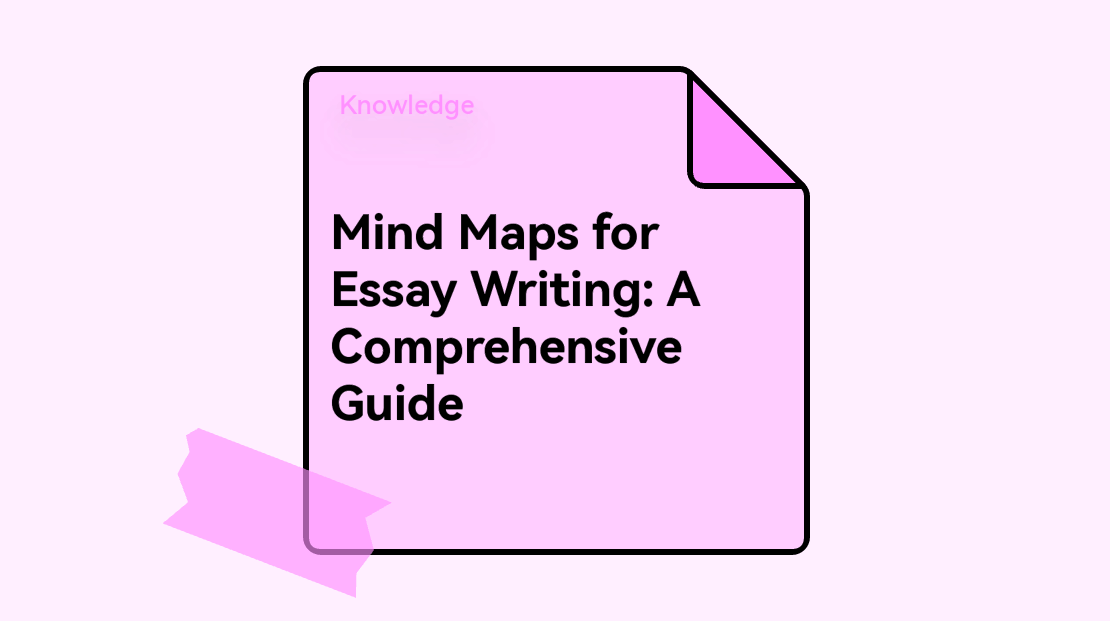
Understanding Mind Maps: Definition and Benefits
A Mind Map is a powerful graphic technique that provides a universal key to unlock the potential of the brain. It harnesses the full range of cortical skills – word, image, number, logic, rhythm, color, and spatial awareness – in a single, uniquely powerful manner.
Utilizing mind maps in essay writing offers several benefits. Not only does it provide a visually engaging way to organize ideas, but it also enhances understanding and memory recall. The science behind this phenomenon lies in the way our brain works. By representing information spatially and with images and color, mind mapping stimulates the brain in a much richer and more varied way than traditional note-taking.
How to Create a Mind Map for an Essay
Mind mapping is an easy process that can be mastered with practice. Here's a step-by-step guide:
1. Start in the center: Write your main idea or essay prompt in the center of the page and draw a circle around it.
2. Branch out: From your central idea, draw lines out towards the edges of your page representing the main thoughts or ideas related to your topic. At the end of each line, write a single word or phrase that summarizes the point, then draw a circle around that word or phrase.
3. Add details: Draw smaller lines branching off from each main idea line that represent supporting details. At the end of these lines, write a brief detail or example and circle it.
4. Color your thoughts: Add colors to your different ideas to highlight them. Use pictures or symbols wherever applicable.
Essential tools for mind mapping range from simple pen and paper to advanced mind mapping software like Boardmix or EdrawMind.
How to Use Mind Maps for Effective Essay Writing
Mastering the use of mind maps for essay writing entails three primary steps – identifying an apt essay topic, kickstarting the research process, and finally, outlining your essay within a mind map. Here's a detailed exploration of these stages:
Step 1: Using a Mind Map to Find a Good Topic for Your Essay
Selecting an engaging and manageable topic forms the bedrock of an impactful essay. Mind mapping can be instrumental in this process by helping to generate and connect ideas creatively and logically.
Brainstorming Topic Ideas with a Mind Map
To brainstorm topics, start by jotting down a general area of interest at the center of your mind map. Let's say, "Climate Change." Now, let your mind flow freely and create branches from this central node, each representing a different aspect or question related to Climate Change - "Causes," "Effects," "Solutions," "Controversies," etc. From these primary branches, draw secondary branches for further thoughts, arguments, or subtopics. After creating this mind map, assess the feasibility and interest level of each potential essay topic, and choose the one that resonates the most with you.
Step 2: Start the Research Process
Once you've chosen your topic, it's time to delve into research. A well-researched essay strengthens your arguments and adds credibility to your work.
Collecting Research in a Mind Map
Begin by creating a new mind map with your chosen topic at the center. As you start reading relevant resources - books, articles, or websites - extract key points and note them as branches on your mind map. For instance, under the "Causes" branch for Climate Change, you could add sub-branches like "Industrialization," "Deforestation," or "Carbon Emissions." Under each of these, note relevant data or quotations from your sources. This approach helps to visualize how various bits of information relate to each other and makes it easier to structure your essay later.
Step 3: Outlining Essay Paper in a Mind Map
Having gathered adequate research material, it's time to structure it coherently through an essay outline. Creating this outline within a mind map ensures that no crucial point is overlooked and allows you to visualize the logical flow of your essay.
From your research mind map, create another one specifically for your essay outline. The central node should be your essay title or thesis statement. Create major branches for each key argument or point you plan to discuss. Attach supporting evidence, examples, or sub-arguments as sub-branches. Under each major branch, ensure that there is a claim or unique viewpoint that you will defend or explain in your essay.
In essence, this mind map will act as the skeleton of your essay, providing a clear roadmap for your writing process.
5 Examples of Mind Maps for Essay Writing
Analyzing examples of mind maps for essay writing can provide a better understanding of how this powerful brainstorming tool works. Here are five detailed examples that demonstrate different ways to utilize mind mapping in academic writing.
Example 1: Argumentative Essay Mind Map
Let's consider a mind map developed for an argumentative essay about "Climate Change". The central node, in this case, states "Climate Change". From this central idea, branches emerge that represent the main arguments for the essay. One branch could say "Evidence of Climate Change," with sub-branches exploring different scientific studies that support climate change. Another branch might state "Effects of Climate Change," delving into the impact on polar ice caps, rising sea levels, and wildlife extinction. A third branch may argue "Solutions to Climate Change," examining renewable energy sources, deforestation reduction, and government policies. Each branch further divides into smaller branches providing details, examples, or counterarguments.

Example 2: Descriptive Essay Mind Map
Now, imagine a descriptive essay about "A Winter Morning". The central node would depict the essay's main theme. Major branches could represent sensory details, such as sight, sound, touch, taste, and smell. For instance, the sight branch might have sub-branches like "white snow," "gray skies," or "bare trees." Each of these would break down into more detailed descriptions.
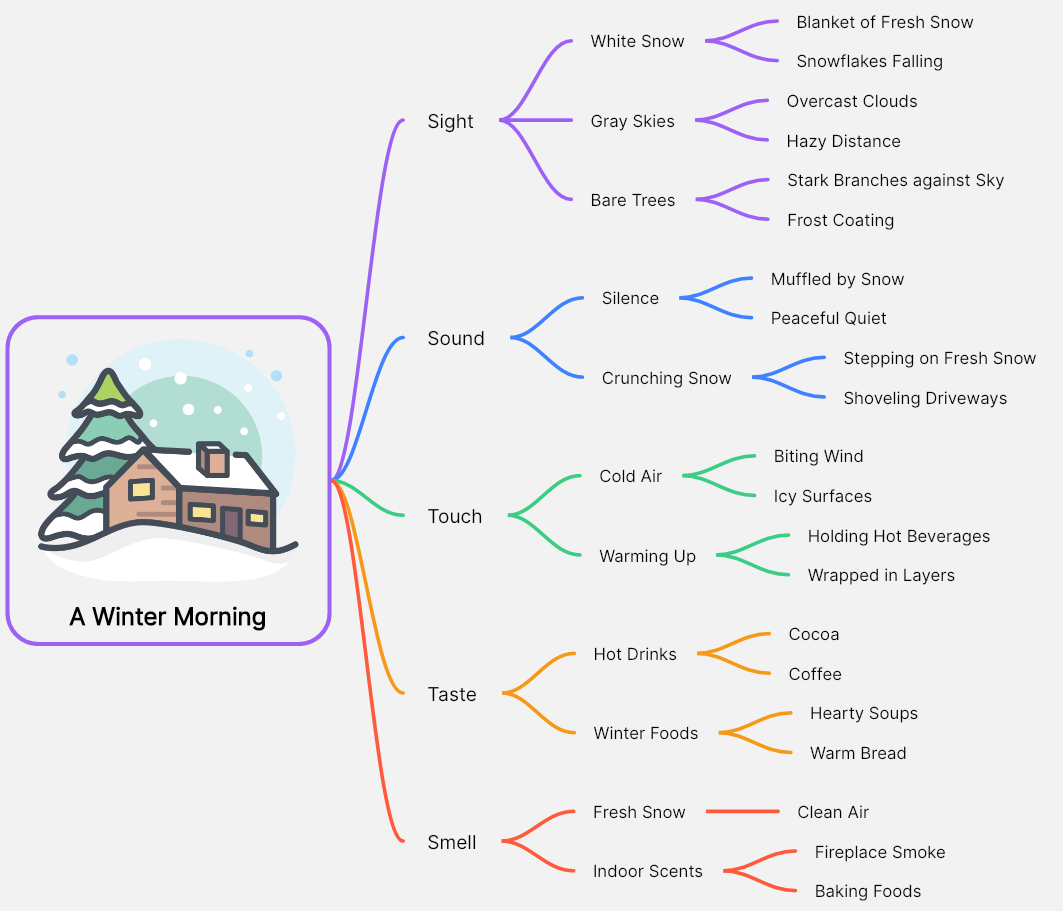
Example 3: Compare and Contrast Essay Mind Map
In a compare and contrast essay on "Traditional Classrooms vs. Online Learning," each of these educational modes could form a major branch from the central node. Sub-branches would then depict aspects for comparison, such as learning flexibility, student-teacher interaction, technology usage, assessment methods, etc. Each of these sub-branches would further branch out into specific points for both traditional classrooms and online learning environments.
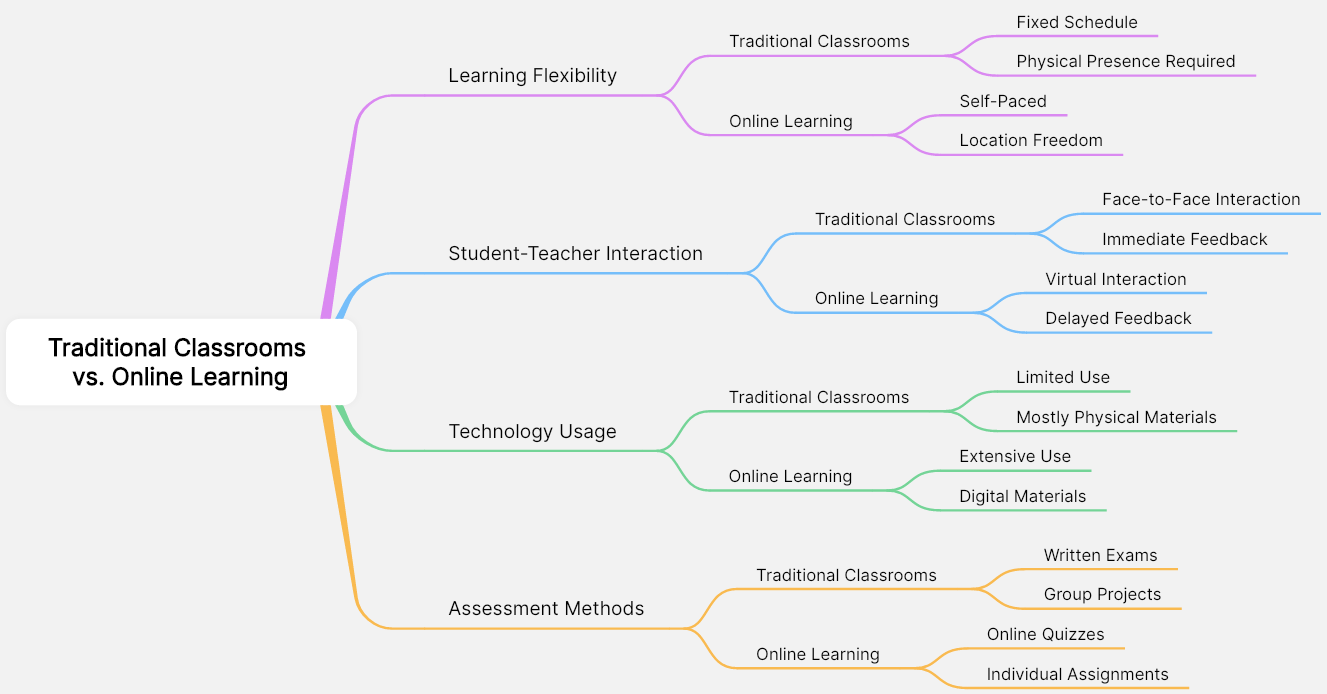
Example 4: Cause and Effect Essay Mind Map
For a cause and effect essay on "Smoking", one major branch might represent "Causes of Smoking" such as peer pressure, stress, and advertising influence. Another major branch could depict the "Effects of Smoking," branching out into health impacts (lung cancer, heart disease), financial costs, and societal effects. Each point could be further elaborated through additional branches.
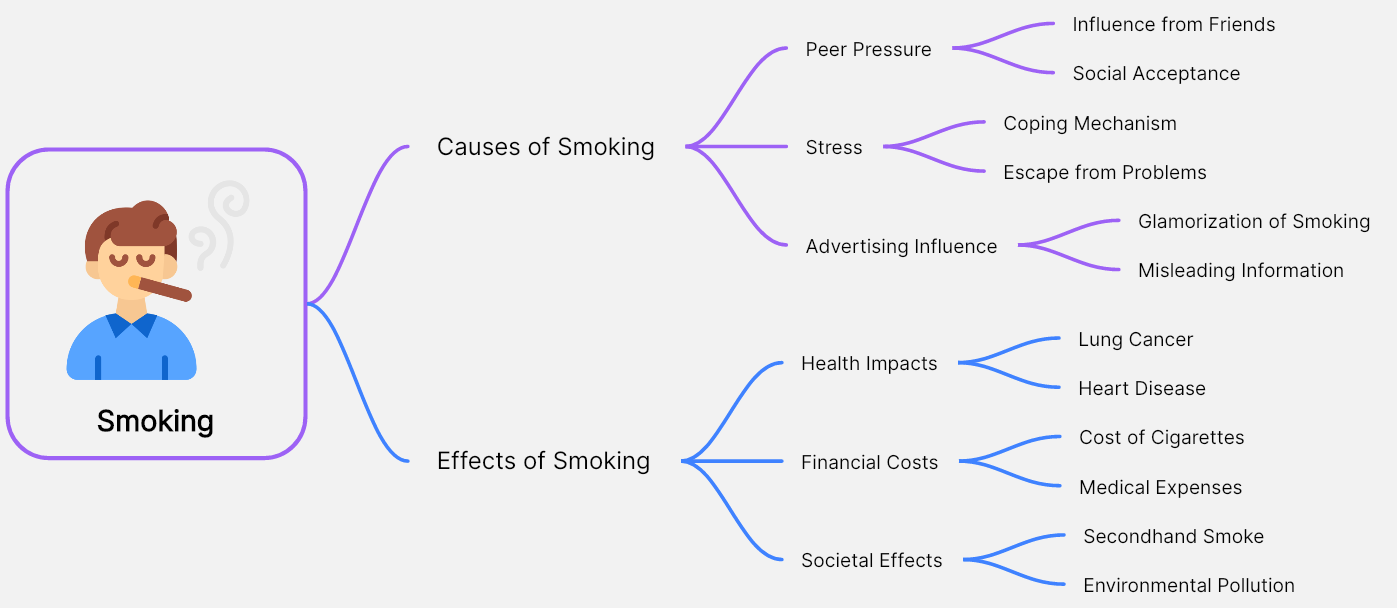
Example 5: Narrative Essay Mind Map
A narrative essay on "My First Camping Trip" would involve major branches for each key event in the story's progression - setting up camp, exploring the forest, facing a wildlife encounter, and handling a campfire accident. Sub-branches of these main events would provide specific details and dialogue to enrich the narrative.
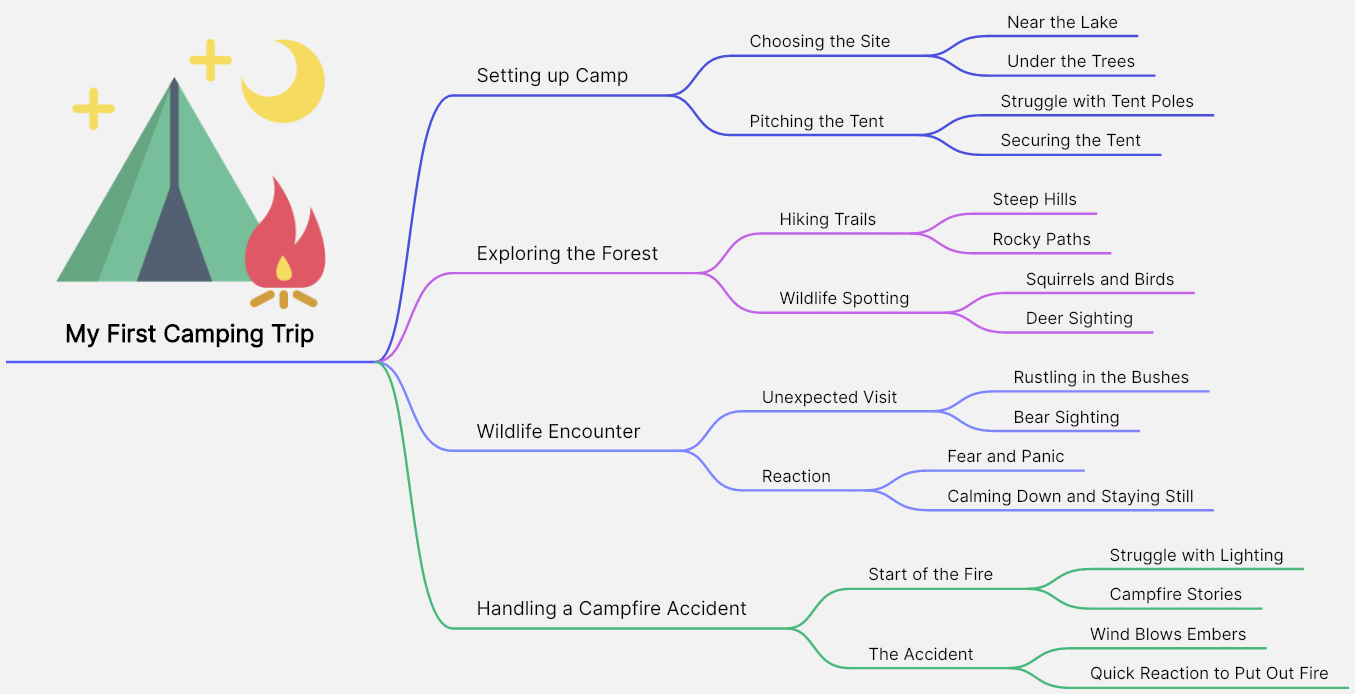
Some Tips and Tricks for Effective Mind Mapping
For effective mind mapping, follow these tips:
- Be creative and make your map vibrant.
- Use single words or simple phrases for information brevity.
- Keep your mind map clear by using radial hierarchy or outlines to embrace your branches.
- Review regularly to reinforce memory.
While creating a mind map, avoid cluttering information on one branch. Use balance across your mind map while distributing information.
Reinventing Essay Writing with Mind Maps
Mind mapping, when mastered, can be a game-changer in your academic writing. It helps organize thoughts, enhances memory and understanding, and can make the essay writing process smoother and more efficient.
Through this guide, you've learned the benefits of mind mapping, how to create a mind map, seen some examples, got expert tips, and learned how to incorporate it into your essay writing process. Now it's time to put this knowledge into practice and start revolutionizing your essay writing with mind maps!













